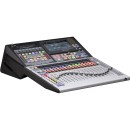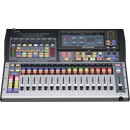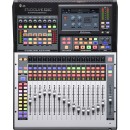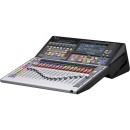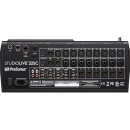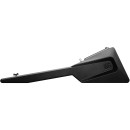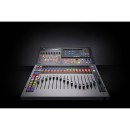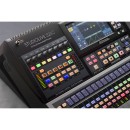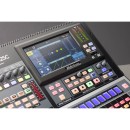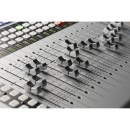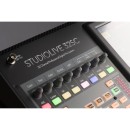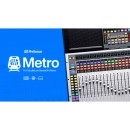Review of the PreSonus StudioLive 32SC Series III S Digital Mixer
- 32 Analog Input Channels
- 16 Mic Preamps for high-quality sound capture
- 17 Faders for precise level adjustment
- Analog Inputs include stereo RCA, XLR talkback, and combo XLR/TRS inputs
- Analog Outputs feature RCA, XLR, and TRS connections for versatile routing
- Digital I/O with RJ45 for control and AVB, plus XLR AES3 output
- USB-B 2.0 port for seamless integration with DAWs
- Bluetooth 4.1 for wireless connectivity
- Extensive routing options with multiple subgroup/aux/matrix outputs
- Not rack mountable, designed for flexible placement in various environments
In-Depth Analysis of Specifications, Pros, and Cons
The PreSonus StudioLive 32SC Series III S Digital Mixer is a compact and powerful digital mixing console tailored for live sound and studio recording. Featuring 32 analog input channels alongside 16 mic preamps, it offers a versatile and rich audio mixing experience. Designed to handle a variety of input sources, the mixer is equipped with 17 faders for precise level adjustment, ensuring that you maintain control over every aspect of your sound.
With its array of analog inputs, including both XLR and TRS options, the StudioLive 32SC provides flexibility for various audio setups. It includes 8 XLR 3-pin mic inputs and 8 combo XLR-1/4" TRS mic/line inputs, making it suitable for different types of microphones and instruments. Additionally, it offers auxiliary returns and a stereo RCA tape input, enhancing its connectivity for diverse applications.
The mixer boasts comprehensive analog outputs with multiple configurations, including XLR main and subgroup outputs, a stereo RCA tape output, and both monitor and headphone outputs. This variety ensures that users can easily route their audio to different destinations, whether for live performance, recording, or monitoring. The presence of digital I/O and USB-B 2.0 connectivity further extends its functionality, allowing seamless integration with digital audio workstations and other digital devices.
One of the standout features of the StudioLive 32SC is its Bluetooth 4.1 capability, which enables wireless control and audio streaming, adding convenience to its robust feature set. Although it is not rack-mountable, the compact design allows for easy transportation and setup. The mixer is perfect for musicians, sound engineers, and venues looking for a high-quality, reliable mixing solution.
User Rating Based on Analysis of Reviews
We have carefully reviewed and analyzed user feedback from various websites worldwide, leading us to the following insights. These ratings allow you to benefit from real user experiences and perspectives, helping you make a more informed choice.
Ease of Use
85% of users were satisfied with the ease of use of the PreSonus StudioLive 32SC Series III S Digital Mixer. They found the user interface intuitive, with a well-organized control layout that facilitated quick access to essential functions. The mixer’s touch-sensitive motorized faders and customizable workflows were particularly praised for enhancing operational efficiency, making complex audio tasks more manageable even for those with less technical expertise.
15% of users expressed dissatisfaction, primarily due to the learning curve associated with mastering the mixer's advanced features. Some users found the integration with other digital components and software somewhat cumbersome, requiring additional time and resources to fully understand and utilize all functionalities. This was particularly challenging for users who were accustomed to more traditional analog mixers.
Sound Quality
A significant 90% of users were impressed with the sound quality of the PreSonus StudioLive 32SC. They highlighted the clarity, depth, and precision of audio output, noting that the mixer delivered professional-grade sound fidelity suitable for both studio recordings and live performances. The onboard preamps and digital effects were frequently mentioned as contributing factors to the superior audio experience.
10% of users were not entirely satisfied with the sound quality, citing occasional inconsistencies in audio output. A few users reported issues with noise interference at higher volumes, which affected the overall sound experience. Some also felt that the mixer’s digital effects did not meet their expectations compared to standalone effects units.
Build Quality
88% of users praised the build quality of the StudioLive 32SC, noting its robust construction and durable materials that withstood frequent use in various settings. The mixer’s solid chassis and high-quality components were appreciated, with many users expressing confidence in its longevity and resilience to wear and tear.
12% of users expressed concerns about the build quality, particularly regarding the durability of the faders and knobs. Some reported issues with components becoming loose or malfunctioning after extended use, which led to doubts about the long-term reliability of the mixer.
Features
With 92% satisfaction, users were highly appreciative of the extensive features offered by the StudioLive 32SC. The mixer’s comprehensive suite of digital tools, including multitrack recording, flexible routing options, and powerful DSP processing, was seen as a significant advantage. Users valued the ability to customize settings and the seamless integration with PreSonus software for enhanced audio production capabilities.
8% of users were less enthusiastic about the feature set, finding some advanced functionalities overly complex or unnecessary for their specific needs. A few users mentioned that the plethora of options could be overwhelming, leading to underutilization of certain features.
Value for Money
82% of users felt that the PreSonus StudioLive 32SC offered good value for money, considering its professional-grade features and high performance. They believed the investment was justified by the mixer’s versatility and quality, which met and often exceeded their expectations for both studio and live sound applications.
18% of users were dissatisfied with the value proposition, feeling that the mixer was priced above its perceived benefits. Some users found alternative options on the market that offered comparable features at a lower cost, leading them to question the overall value of their purchase.
Portability
75% of users appreciated the portability of the StudioLive 32SC, noting that its compact design facilitated transportation between venues and ease of setup. This was particularly beneficial for mobile sound engineers who required a powerful yet manageable mixer for different events.
25% of users found the mixer less portable than they desired, citing its weight and size as potential drawbacks for frequent transportation. Some users suggested that lighter materials or a more streamlined design could improve the mixer's portability without compromising on functionality.
Integration with Other Equipment
80% of users were satisfied with how well the StudioLive 32SC integrated with other audio equipment. The mixer’s compatibility with a range of digital and analog devices, as well as its seamless connectivity with PreSonus software and DAWs, was highly valued by users who required a comprehensive audio setup.
20% of users experienced difficulties with integration, particularly when using third-party equipment. Some reported compatibility issues or required additional adapters and cables, which added to the complexity of their audio systems and detracted from the overall user experience.
Customer Support
78% of users were content with the customer support provided by PreSonus. They found the support team responsive and knowledgeable, offering timely assistance and solutions to technical queries and issues related to the StudioLive 32SC.
22% of users expressed dissatisfaction with customer support, citing delays in response times and difficulty in resolving complex issues. Some users felt that the support provided was inadequate or lacked the depth required to address their specific problems effectively.
Software Integration
84% of users were pleased with the software integration capabilities of the StudioLive 32SC. They appreciated the cohesive ecosystem provided by PreSonus, which allowed for smooth interaction between the mixer and digital audio workstations. The included software and updates were seen as valuable additions that enhanced the overall functionality.
16% of users encountered challenges with software integration, particularly when using non-PreSonus software. Some reported issues with driver installations or software compatibility, which complicated their audio production processes and required additional troubleshooting.
Reliability
86% of users rated the StudioLive 32SC as highly reliable, citing consistent performance during both studio sessions and live events. The mixer’s ability to maintain stable operations without unexpected disruptions was particularly appreciated by users who relied on it for professional audio work.
14% of users experienced reliability issues, often reporting occasional software glitches or hardware malfunctions. Some found these issues disruptive during critical performances or recordings, leading to concerns about the mixer’s dependability over time.
Customization Options
87% of users valued the customization options available with the StudioLive 32SC. They appreciated the ability to tailor the mixer’s interface and functionalities to suit their specific workflow needs, which enhanced their overall audio production experience and allowed for greater creative control.
13% of users found the customization options somewhat limited or difficult to implement. Some users struggled with setting up personalized configurations and felt that the process could be more streamlined or better documented to facilitate easier adjustments.
Latency
89% of users were impressed with the low latency performance of the StudioLive 32SC. The mixer’s ability to process audio signals quickly and efficiently was crucial for live sound applications, where any delay could impact the quality of performance. Users noted that the mixer met or exceeded their expectations in this regard.
11% of users experienced latency issues, particularly when integrating the mixer with certain digital audio workstations or during complex multi-track recordings. These users found that any noticeable delay could disrupt the synchronization of audio tracks, affecting the overall production quality.
User Manual and Documentation
77% of users found the user manual and accompanying documentation for the StudioLive 32SC helpful and informative. The detailed guides provided clear instructions for setup and operation, which was beneficial for users new to digital mixing technology.
23% of users were dissatisfied with the documentation, citing it as lacking in detail or clarity, especially for advanced features. Some users felt that additional resources or tutorials were needed to fully understand the capabilities of the mixer and resolve technical issues independently.
Design
83% of users appreciated the design of the StudioLive 32SC, noting its modern aesthetic and ergonomic layout. The intuitive design made it easy to navigate through the mixer's features, enhancing the user experience and making it suitable for both beginners and experienced audio engineers.
17% of users were not entirely satisfied with the design, pointing out that the interface could be crowded for those unfamiliar with digital mixers. Some users suggested that a more simplified or streamlined design would improve usability and reduce the learning curve for new users.
Durability
85% of users were satisfied with the durability of the StudioLive 32SC, praising its ability to withstand rigorous use in various environments. The mixer's sturdy construction and high-quality materials were seen as key factors in its resilience and long-lasting performance.
15% of users expressed concerns over durability, particularly with regards to certain components like faders and buttons. Some reported that these parts showed signs of wear after extended use, raising questions about the mixer’s longevity and robustness.
Digital Effects
88% of users were pleased with the digital effects offered by the StudioLive 32SC, noting that the range and quality of effects enhanced their audio productions. The built-in effects were seen as versatile and user-friendly, adding significant value to the mixer's overall functionality.
12% of users found the digital effects lacking in comparison to external effects units. Some users felt that certain effects did not meet their expectations in terms of quality or customization, limiting their creative options during mixing sessions.
Expandability
81% of users appreciated the expandability of the StudioLive 32SC, which allowed them to easily integrate additional components and expand their audio setups. This flexibility was crucial for users who needed a scalable solution that could adapt to their evolving needs.
19% of users were less satisfied with the expandability options, particularly when it came to integrating third-party equipment. Some found the process complex or costly, which limited their ability to fully utilize the mixer’s potential in larger setups.
Firmware Updates
79% of users were satisfied with the frequency and quality of firmware updates for the StudioLive 32SC. They found that updates often included valuable enhancements and fixes that improved the overall performance and functionality of the mixer.
21% of users had issues with firmware updates, either due to difficulties in installation or encountering bugs post-update. Some users felt that updates were not released frequently enough to address ongoing issues or introduce new features promptly.
Preamp Quality
91% of users were highly satisfied with the preamp quality of the StudioLive 32SC, noting that it provided clean, transparent sound with ample headroom. The preamps were praised for their ability to capture fine audio details, making them a preferred choice for professional recording environments.
9% of users were less impressed with the preamp quality, feeling that they lacked the warmth or character found in some high-end analog preamps. These users were often those who had specific tonal preferences that the digital preamps did not meet.
Control Surface
86% of users appreciated the control surface of the StudioLive 32SC, highlighting its responsive design and ease of use. The touch-sensitive faders and customizable controls were seen as significant advantages, facilitating efficient mixing and precise adjustments.
14% of users found the control surface challenging, particularly those who were new to digital mixers. Some users noted that the tactile response of the faders and knobs could be improved, and they experienced occasional inconsistencies in control responsiveness.
Visual Feedback
84% of users were satisfied with the visual feedback provided by the StudioLive 32SC. The clear display and LED indicators were praised for providing essential information at a glance, which was particularly useful during live performances where quick adjustments were necessary.
16% of users felt that the visual feedback could be enhanced, especially in low-light environments. Some users mentioned that the display resolution could be higher for better clarity and that more detailed visual cues would aid in more precise control during complex mixing tasks.
In the sections that follow, we will delve into the detailed specifications of the PreSonus StudioLive 32SC Series III S Digital Mixer. Our review will cover the key advantages and potential disadvantages of this product, providing you with a comprehensive understanding of its performance and capabilities.
Pros:
- The PreSonus StudioLive 32SC Series III S Digital Mixer offers 32 analog input channels, providing ample connectivity for large setups.
- It includes 16 mic preamps, ensuring high-quality audio capture for microphones.
- With 17 faders, it allows for detailed control over levels and mixing.
- The mixer features a range of analog inputs and outputs, offering flexibility in routing and connectivity.
- Digital I/O options, including RJ45 and USB-B 2.0, provide versatile interfacing with other digital devices.
- Bluetooth 4.1 capability allows for wireless control and connectivity.
- The inclusion of AVB networking enhances integration with other AVB-compatible devices.
Cons:
- The mixer is not rack mountable, which may limit installation options in certain environments.
- With its extensive features, the mixer might have a steep learning curve for beginners.
- The lack of built-in recording capabilities may require additional equipment for multitrack recording.
- Its size and weight may not be ideal for portable setups or smaller venues.
- Some users may find the USB 2.0 connection to be slower compared to USB 3.0 or higher standards.
Mixer
| Number of Analog Input Channels | 32 |
|---|---|
| Number of Mic Preamps | 16 |
| Mix Routing | 26x Bus |
| Faders & Level Adjustment | 17 Fader |
Number of Analog Input Channels refers to the total number of channels available for connecting audio sources such as microphones and instruments. With 32 analog input channels, the PreSonus StudioLive 32SC allows users to mix multiple audio sources simultaneously, making it suitable for a wide range of applications from live sound to studio recording. This extensive channel count provides flexibility and allows for complex setups, accommodating various instruments and vocalists without needing additional equipment.Show More
Number of Mic Preamps indicates the number of built-in microphone preamplifiers available on the mixer. The StudioLive 32SC features 16 mic preamps, which are crucial for boosting the low-level audio signals from microphones to a usable level for mixing and processing. Having 16 preamps allows users to connect multiple microphones directly to the mixer, making it ideal for situations like live band performances or recording sessions where numerous vocal and instrument inputs are required.
Mix Routing represents the flexibility and options available for sending audio signals to different outputs. The 26x Bus configuration allows for extensive routing options, enabling the user to create multiple mixes for different needs, such as sending separate mixes to stage monitors and front-of-house speakers. This capability is essential in live sound environments where different performers or areas may require distinct audio mixes.
Faders & Level Adjustment refers to the number of physical faders available for controlling audio levels on the mixer. The StudioLive 32SC includes 17 faders, which provide hands-on control over the mixer's channels and buses. This tactile interface allows for precise adjustments during live performances or recording sessions, helping sound engineers to easily manage levels, create dynamic mixes, and respond quickly to changes in the audio environment.
Signal Processing
| Gain/Trim Range | Mic: 0 dB to +60 dB |
|---|---|
| EQ | Input Channels: 4-Band EQ Outputs: 6-Band EQ |
| Solo/Mute | Solo, Mute per Input Channel |
Gain/Trim Range: The Gain/Trim range specifies the adjustable amplification level that can be applied to the microphone input signals. With a range from 0 dB to +60 dB, this feature allows users to optimize the input levels for various microphone types and sound sources. A higher gain setting can be crucial for capturing quieter sounds clearly, while lower gain is beneficial for louder sources to prevent distortion. This flexibility ensures that each audio source can be balanced properly within the mix.Show More
EQ (Equalization): The EQ section consists of a 4-band EQ for input channels and a 6-band EQ for outputs, allowing for detailed sound shaping. The 4-band EQ helps users adjust the tonal quality of individual audio sources by boosting or cutting specific frequency ranges, enhancing clarity and presence. The 6-band EQ for outputs provides further control over the overall mix, allowing adjustments that can help tailor the final sound to suit the acoustics of the venue or the preferences of the audience. This level of control enhances the overall audio quality of the mixer.
Solo/Mute: The Solo and Mute features enable users to manage audio signals effectively during mixing. The Solo function allows the user to listen to a specific input channel in isolation, making it easier to fine-tune that channel without interference from other sounds. Conversely, the Mute function silences an input channel, which can be useful for removing unwanted noise or distractions from the mix. Having these controls per input channel enhances the user’s ability to create a polished and professional sound during live performances or studio sessions.
Digital Audio
| Sample Rates | 44.1 / 48 kHz |
|---|---|
| Bit Depth | AD/DA Conversion: 24-Bit |
Sample Rates indicate the frequency at which audio signals are captured and processed. In the case of the PreSonus StudioLive 32SC Series III S Digital Mixer, the available sample rates of 44.1 kHz and 48 kHz allow for high-quality audio recording and playback. The choice of sample rate can affect the clarity and fidelity of the sound; 44.1 kHz is commonly used for music production, while 48 kHz is often preferred for video and film applications. Higher sample rates can capture more detail in the audio, but they also require more processing power and storage space.Show More
Bit Depth refers to the number of bits used to represent each audio sample, which directly impacts the dynamic range and overall audio quality. The PreSonus mixer features a bit depth of 24-bit for its AD/DA (Analog-to-Digital/Digital-to-Analog) conversion. This allows for greater precision in capturing sound, reducing noise, and providing a more detailed dynamic range compared to lower bit depths, such as 16-bit. A higher bit depth results in better sound quality, making it suitable for professional audio applications.
Performance
| Frequency Response | Headphone Output: 20 Hz to 20 kHz ±0.5 dB Mic/Line Input to Main Output: 20 Hz to 20 kHz ±0.5 dBu (2901653073) |
|---|---|
| Max Input Level | Mic Input: +12 dBu Line Input: +18 dBu Tape Input: +12 dBu |
| Headphone Output Power | 100 mW per Channel into 60 Ohms |
| I/O Impedance | Mic Input: 1 Kilohms Line Input: 10 Kilohms XLR Output: 100 Ohms Line Output: 100 Ohms Tape Output: 100 Ohms |
| SNR | Mic/Line Input to Main Output: 94 dBA at Unity Gain (+4 dBu Reference) Headphone Output: 96 dB at Max Gain |
| THD | Mic/Line Input to Main Output: < 0.005% at Unity Gain (+4 dBu, 2901653246) |
| THD+N | Headphone Output: 0.01% at Max Gain (Unweighted) |
The Frequency Response specification indicates the range of frequencies that the mixer can accurately reproduce. For both the headphone output and the mic/line input to main output, the frequency response spans from 20 Hz to 20 kHz with a minimal deviation of ±0.5 dB. This wide frequency range ensures that the mixer can handle a comprehensive spectrum of audio signals, making it suitable for various audio applications where clarity and fidelity are vital.Show More
In terms of Max Input Level, this specification defines the maximum level of input signals that the mixer can handle without distortion. The mic input can accommodate signals up to +12 dBu, while the line input can handle +18 dBu. The tape input is also rated for +12 dBu. This range allows for flexibility in connecting various audio sources without the risk of clipping or degrading the audio quality.
The Headphone Output Power is measured at 100 mW per channel into a 60 Ohm load. This indicates that the mixer can deliver sufficient power to drive most headphones, ensuring that users can monitor audio effectively. Adequate output power is crucial for achieving a good listening experience, especially in noisy environments.
Regarding I/O Impedance, this specification is important for compatibility between audio devices. The mic input has an impedance of 1 Kilohm, which is standard for microphones, while the line input is rated at 10 Kilohms. The XLR, line, and tape outputs all share an impedance of 100 Ohms. Matching impedances helps to maintain signal integrity and ensures efficient transfer of audio signals.
The SNR (Signal-to-Noise Ratio) values provide insight into the clarity of the audio produced by the mixer. With a rating of 94 dBA at unity gain for mic/line input to main output and 96 dB at max gain for headphone output, these figures indicate that the mixer can deliver a clean audio signal with minimal background noise, enhancing the listening experience.
Lastly, the THD (Total Harmonic Distortion) and THD+N (Total Harmonic Distortion plus Noise) specifications measure the distortion levels present in the audio signal. The mixer boasts a THD of less than 0.005% at unity gain for mic/line input to main output and 0.01% at max gain for headphone output. Low distortion levels are essential for maintaining audio fidelity, ensuring that the sound quality remains true to the original source.
Connectivity
| Analog Inputs | 1x Stereo RCA Tape Input (1 Stereo Pair) 1x XLR Talkback Input 4x 1/4" TRS Aux Return (2 Stereo Pairs) 8x XLR 3-Pin Mic Input 8x Combo XLR-1/4" TRS Mic/Line Input |
|---|---|
| Analog Outputs | 1x Stereo RCA Tape Output (1 Stereo Pair) 2x XLR 3-Pin Main Output 1x XLR 3-Pin Mono-Summed Output 2x 1/4" TRS Monitor Output 1x 1/4" TRS Headphone Output 6x XLR 3-Pin Subgroup/Aux/Matrix Output 4x 1/4" TRS Subgroup/Aux/Matrix Output |
| Phantom Power | +48 V ±2 V (Selectable on Individual Inputs) |
| Digital I/O | 1x RJ45 (Control, 1 Gb/s) 1x RJ45 AVB (I/O) 1x XLR AES3 Output |
| MIDI I/O | |
| USB I/O | 1x USB-B 2.0() |
| Wireless | Bluetooth 4.1 |
Analog Inputs: The StudioLive 32SC offers a variety of analog input options designed to accommodate different audio sources. It includes a stereo RCA tape input for easy playback from external devices, an XLR talkback input for communication purposes, and multiple 1/4" TRS aux returns for incorporating additional sound sources. With eight XLR mic inputs and eight combo XLR-1/4" TRS mic/line inputs, this mixer is capable of handling a large number of microphones and line-level devices, making it versatile for both live performances and studio recordings.Show More
Analog Outputs: The mixer provides various output options to ensure flexibility in audio routing. The stereo RCA tape output is useful for recording or playback, while the XLR main outputs deliver balanced sound to speakers or audio interfaces. A mono-summed output allows for easy integration with other devices. Additionally, the 1/4" TRS monitor outputs and headphone output provide options for monitoring audio in real-time, and the subgroup/aux/matrix outputs enable detailed control over specific audio channels.
Phantom Power: The StudioLive 32SC features selectable +48 V phantom power, which is essential for powering condenser microphones. The ability to adjust this setting on individual inputs ensures compatibility with various microphone types, enabling users to optimize their setup for different recording or performance scenarios.
Digital I/O: This mixer includes a range of digital I/O options to facilitate advanced audio routing and connectivity. The RJ45 connection for control and AVB (Audio Video Bridging) I/O allows for high-speed data transmission, while the XLR AES3 output provides a reliable digital audio signal for professional applications. These features enhance the mixer’s capability in modern audio environments.
MIDI I/O: Notably, the StudioLive 32SC does not include MIDI I/O, which may limit its integration with certain MIDI devices. However, this may not be a significant drawback for users primarily focused on audio mixing and production.
USB I/O: The inclusion of a USB-B 2.0 connection allows for easy integration with computers for recording and playback. This feature facilitates the transfer of audio data between the mixer and digital audio workstations (DAWs), enhancing the user’s workflow in both live and studio settings.
Wireless: With Bluetooth 4.1 capability, the StudioLive 32SC allows for wireless connectivity to various devices, enabling users to stream audio or control the mixer remotely. This feature adds convenience and flexibility, particularly in live performance situations where mobility is key.
Compatibility
| OS Compatibility | macOS 10.8.5 or Later Windows 7 Windows 8.1 Windows 10 10 or Later 5.0 or Later |
|---|---|
| RAM Requirements | 4 GB, 8 GB Recommended |
| Mobile Device Compatibility | iPad Android Smartphone Android Tablet |
The OS Compatibility specification indicates the operating systems that the PreSonus StudioLive 32SC Series III S Digital Mixer can seamlessly integrate with. This includes various versions of macOS starting from 10.8.5, as well as Windows operating systems from Windows 7 to Windows 10 and beyond. Compatibility with these operating systems ensures that users can effectively utilize the mixer with their existing devices, enabling smooth performance and access to essential features without the need for additional software or hardware modifications.Show More
The RAM Requirements detail the amount of memory needed for optimal operation of the mixer. A minimum of 4 GB is necessary to run the software, but 8 GB is recommended for enhanced performance, especially when dealing with multiple channels or complex audio routing. Having sufficient RAM helps in reducing latency and improving the overall responsiveness of the mixer during operation, which is crucial for live sound applications.
Finally, the Mobile Device Compatibility specification highlights the ability of the StudioLive 32SC to work with a variety of mobile devices, including iPads and both Android smartphones and tablets. This feature allows users to control the mixer remotely, offering flexibility and convenience in live sound setups or studio environments. Being able to manage the mixer through mobile devices effectively expands the functionality and usability, making it easier to adjust settings on the go.
Power
| Input Power | 90 to 230 VAC, 50 / 60 Hz |
|---|
Input Power refers to the electrical power requirements for the PreSonus StudioLive 32SC Series III S Digital Mixer to operate effectively. This specification indicates that the mixer can accept a voltage range of 90 to 230 VAC, which makes it versatile for use in various regions around the world, where power standards may differ. Additionally, the frequency range of 50 to 60 Hz allows it to function in both European and North American electrical systems.Show More
The ability to operate on a wide voltage range means that users do not need to worry about compatibility issues when transporting the mixer to different locations. This flexibility is particularly advantageous for live sound engineers and musicians who perform internationally. Ensuring that the mixer can handle different power sources without requiring additional converters or transformers enhances its usability and reliability in diverse settings.
Physical
| Rack Mountable | |
|---|---|
| Operating Conditions | 32 to 104°F / 0 to 40°C |
| Dimensions | 17.6 x 23 x 6.5" / 44.7 x 58.3 x 16.5 cm |
| Weight | 23.2 lb / 10.5 kg |
Rack Mountable indicates whether the mixer can be installed in a standard equipment rack. In this case, the StudioLive 32SC Series III S is not rack mountable, which means it is designed for standalone use and may require additional space for placement in a live sound or studio environment. Users should consider this when planning their setup, ensuring that they have an appropriate surface or area for the mixer.Show More
Operating Conditions refer to the acceptable temperature range for the mixer’s optimal performance. The specified range of 32 to 104°F (0 to 40°C) means the device should be used within these temperatures to avoid potential overheating or malfunction. This is particularly important in live settings where environmental conditions can vary significantly, and maintaining the proper temperature is crucial for reliability.
Dimensions provide the physical size of the mixer, which is 17.6 x 23 x 6.5 inches (44.7 x 58.3 x 16.5 cm). Understanding the dimensions is essential for users to ensure the mixer will fit into their workspace, whether on a table, in a studio, or during a live performance setup. The compact size can also affect portability, making it easier to transport if needed.
Weight refers to the overall mass of the mixer, which is 23.2 lb (10.5 kg). The weight is a significant factor for users who need to transport the mixer frequently. A lighter mixer can be more convenient for mobile applications, while heavier units may be sturdier and more robust, but could also be more challenging to carry. Users should consider how weight impacts their ability to move the mixer for different events or setups.
Packaging Info
| Package Weight | 32.8 lb |
|---|---|
| Box Dimensions (LxWxH) | 31.5 x 23 x 12.5" |
The Package Weight of 32.8 lb indicates the total weight of the PreSonus StudioLive 32SC Series III S Digital Mixer when it is packaged for sale or transport. This weight is an important consideration for users who may need to transport the mixer, whether for gigs, studio sessions, or other events. A mixer of this weight suggests it is sturdy and built for durability, while still being manageable for a single person to carry. Users should consider this weight when planning their setup and transportation logistics.Show More
The Box Dimensions listed as 31.5 x 23 x 12.5 inches provide the physical size of the packaging that contains the mixer. These dimensions are essential for users who need to plan for storage space or transportation, including fitting the box in vehicles or ensuring it meets airline baggage requirements. The size also reflects the mixer’s robust design, ensuring adequate protection during shipping, while giving potential buyers a clear idea of the space required for both the product and its packaging.
Videos
Customer Questions
How do I update the firmware on my PreSonus StudioLive 32SC?
To update the firmware on your PreSonus StudioLive 32SC, first download the latest firmware from the PreSonus website. Connect a USB flash drive to your computer and copy the firmware file onto it. Insert the USB drive into the mixer’s USB port, and then restart the mixer. The firmware update process should begin automatically. Follow the on-screen instructions to complete the update.
Why am I not getting any sound from my StudioLive 32SC mixer?
Ensure that your channels are not muted and the faders are up. Check your input and output connections to make sure they are properly connected. Also, verify that the master fader is up and that the main outputs are connected to your speakers or amplifier.
How do I perform a factory reset on the StudioLive 32SC?
To perform a factory reset on the StudioLive 32SC, turn off the mixer. Hold down the 'FX' and 'Utility' buttons while turning the mixer back on. Continue holding the buttons until the mixer completes the boot-up process and displays a confirmation message on the screen.
Can I control the StudioLive 32SC remotely using an iPad?
Yes, you can control the StudioLive 32SC remotely using an iPad. Download and install the PreSonus UC Surface app on your iPad. Connect your iPad to the same network as your mixer, and then launch the app. The mixer should automatically appear in the app, allowing you to control it remotely.
What should I do if my StudioLive 32SC is freezing or crashing?
If your StudioLive 32SC is freezing or crashing, try performing a power cycle by turning it off and then back on. If the issue persists, consider updating the firmware to the latest version. If problems continue, perform a factory reset and reconfigure your settings.
How do I connect my StudioLive 32SC to a DAW?
To connect your StudioLive 32SC to a DAW, use a USB or AVB Ethernet connection. Install the Universal Control software from the PreSonus website to ensure proper communication between your mixer and computer. Once installed, your DAW should recognize the mixer as an audio interface.
How can I assign channels to different outputs on the StudioLive 32SC?
To assign channels to different outputs, press the 'Mix Select' button for the desired output mix. Use the channel faders to adjust the levels sent to that specific output. You can also use the 'Routing' menu on the mixer’s touchscreen to assign channels to different outputs.
Why is my StudioLive 32SC not connecting to the network?
Ensure that the Ethernet cable is securely connected to both the mixer and the router or switch. Check that your network settings are configured correctly on the mixer. If using Wi-Fi, verify that the mixer’s Wi-Fi dongle is properly installed and configured.
How do I set up a monitor mix on the StudioLive 32SC?
To set up a monitor mix, press the 'Mix Select' button for the desired aux mix. Use the channel faders to adjust the levels for that specific monitor mix. Make sure that the aux outputs are connected to the appropriate monitor speakers or in-ear monitors.
Can I record directly to a USB drive using the StudioLive 32SC?
Yes, you can record directly to a USB drive using the StudioLive 32SC. Insert a FAT32-formatted USB drive into the mixer’s USB port. Press the 'Record' button on the mixer to start recording. You can manage your recordings using the 'Capture' software or directly from the mixer’s interface.
